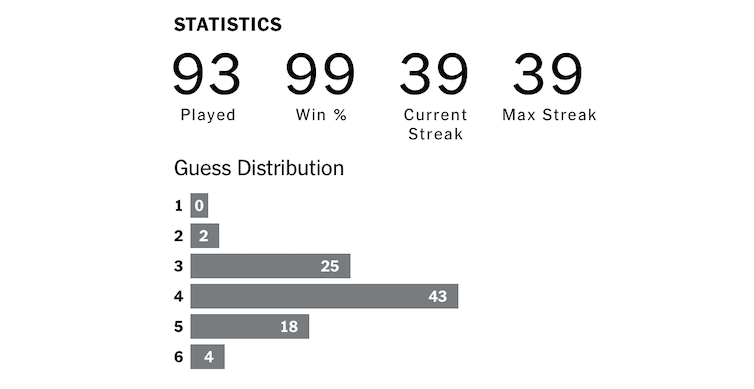Dick Coffee attended 781 consecutive University of Alabama football games. Meg Roh surfed through illness, storms and nightfall to maintain a seven-year daily surfing streak. Jon Sutherland ran at least 1 mile every day for over 52 years.
An activity streak has the power to compel behavior, and marketers have taken note. Marketing researchers Jackie Silverman and Alixandra Barasch recently documented 101 unique instances, including Snapchat, Candy Crush Saga, Wordle and the Duolingo language learning platform, of apps that have incorporated streaks into their architecture by tracking the number of consecutive days users complete a task. There are even apps dedicated solely to tracking streaks.

One user’s Wordle streak of more than a month’s worth of wins.
Screenshot from Wordle on New York Times
What is it about streaks that makes them so compelling? I’m interested in consumer behavior and decision making. For insight into streaks and their motivating influence, I conducted research, recently published in the Journal of the Academy of Marketing Science, on the phenomenon.
What is a streak?
Because there’s no generally accepted definition of what a streak is, I started by trying to define the phenomenon. Based on input from people maintaining streaks and how streaks are described in the popular media, I suggest they have four underlying characteristics.
First, streaks require unchanging performance and temporal parameters. In other words, rules, established by the streaker or others, define what it means to successfully complete the activity and the schedule for doing so. For example, a streak may involve completing a session of 50 pushups every calendar day.
Second, the streak-holder largely attributes completing the activity to his or her resolve.
Third, a streak is a series of the same completed activity that the person maintaining the streak considers to be uninterrupted.
Fourth, the streaker quantifies the series’ duration. For instance, a streak-holder can tell you exactly how many consecutive workdays they’ve biked in to the office, or they can tell you the precise date the streak began.
This definition distinguishes an activity streak from winning streaks and lucky streaks. Unlike activity streaks, winning streaks depend on the performance of others – an opponent – while lucky streaks involve outcomes that are not under the control of the person executing the streak.
My definition also highlights that streaks are perceptual. Some people who have completed an objectively uninterrupted series of an activity may not view that as a streak. Others who have not completed the activity every time the opportunity arises may believe they have a streak.
Is it a streak, habit or collection?
People often engage in behavior patterns, or a recurring way of acting in a given situation. A streak is a form of patterned behavior, but there are others. Most people have habits, which…

